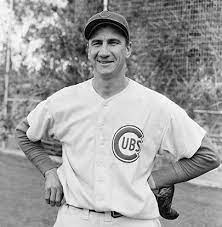Scroll Down to Read Today’s Essay
Subscribe to Baseball History Comes Alive for automatic updates. As a Free Bonus, you’ll get instant access to my Special Report: Gary’s Handy Dandy World Series Reference Guide!
Hank Sauer Photo Gallery
Click on any image below to see photos in full size and to start Photo Gallery:
Baseball’s Forgotten Stars:
The “Mayor of Wrigley Field,” Hank Sauer!
“You hit better with one hand than most of these guys do with two!” – Cubs manager Phil Cavarretta commenting on Hank Sauer hitting with a broken finger
In doing a recent search through the content on my Baseball History Comes Alive website, I realized that I had never even mentioned one of the true stars of the early 1950s, Hank Sauer. Maybe it’s because he played for some miserable Cub teams. Maybe it’s because the many standout players on the great east coast teams of that era hopelessly overshadowed Midwestern stars. Whatever the reason, today I’ll end that oversight by shinning our baseball spotlight on the Cubs’ brightest star before the emergence of Ernie banks, Henry Joseph “Hank” Sauer.
The 6’3”, 198-lb. Pittsburgh native spent 15 seasons in the major leagues (1941-1959) playing for the Reds (1941-’42, ’45, ’48-’49), Cubs (1949-’55), Cardinals (1956), and Giants (1957-’59), with time loss to military service during WWII. Primarily a left fielder, he made his major league debut on September 9, 1941 as a member of the Reds. Over his career, he batted .266 with 1278 hits, 288 home runs, and 876 RBIs. His OPS+ of 123 ranks him well above his major league contemporaries (100 being the major league average).
His best years came during his seven seasons with the Cubs, for whom he hit .266 with 198 homers, and 587 RBIs, including winning the 1952 MVP award. That year, the two-time All-Star hit .270 and led the league in home runs (37) and RBIs (121), to go with a .361 on-base percentage.
However, his best season was 1954, when he hit .288 and recorded career highs of 41 home runs, 98 runs, .375 on-base percentage, .563 slugging average, and a .938 OPS. A great year by any measure, but for some reason, Hank failed to crack the top-25 in MVP voting. In addition to his 37 round-trippers in 1952 and 41 in 1954, Hank also put up home run numbers of 27, 32 and 30 as a Cub.
Other career highlights: hitting a two-run homer in the 1952 All-Star game played at Philadelphia’s Shibe Park. The blast gave the National League a 3-2 win over the American League in the rain-shortened game; and hitting 30 or more home runs six times.
Also of interest is the affection shown to him by Cub fans, where he acquired the nickname, “The Mayor of Wrigley Field”:
He was well known for using smokeless tobacco, and it has often been reported that after he hit a home run, when he returned to his left field position, bleacher fans would shower him with packets of his favorite chew, Beech Nut tobacco. (1)
As is typical of most sluggers, Hank was not known for his foot speed. The Cubs’ sluggish outfield of the early 1950s was too easy of a target for satirical Chicago Daily News columnist Mike Royko to resist. In contrasting the Cubs’ outfield trio of Hank Sauer, Frankie Baumholtz, and Ralph Kiner with the Phillies’ “Whiz Kids,” Royko quipped:
“The Cubs had an outfield that was so slow they were known as the Quicksand Kids.” (2)
Whenever you take a deep look into the careers of major leaguers, invariably you’ll find something interesting. Such is the case with Hank Sauer. Seventy-one years ago, on June 11, 1952, in a game in which the Cubs defeated the Phillies 3-2, Hank provided all three runs with three solo blasts at Wrigley Field against the Phillies’ Curt Simmons. What makes this so interesting is that Sauer had done the exact same thing (three home runs in the same game against the same pitcher) in 1950, also against Simmons and the Phillies. In fact, Sauer and Johnny Bench are the only players in major leaguer history to have hit three homers in a single game twice against the same pitcher.
For those of us who never saw Hank Sauer play, we can use the Baseball Reference Similarity Scores feature to compare him to more contemporary players. Hank’s career numbers compare favorably to Danny Tartabull, Jay Buhner, Richie Sexton, Jesse Barfield, Jason Bay, and Josh Donaldson, putting Hank solidly in the “very good but not Hall of Fame worthy” category.
Hank played his last game on August 17, 1959, as a member of the Giants. After he retired, he became a Giants’ coach and later a long-time scout and roving minor league batting instructor for the Giants. Hank died of a heart attack while playing golf in Burlingame, California, on August 24, 2001, at the age of 84.
So today we gladly shine our baseball spotlight on a fine ballplayer from the early 1950s who is often overlooked, Hank Sauer.
Gary Livacari
Subscribe to our website, “Baseball History Comes Alive!” with over 1400 fully categorized baseball essays and photo galleries, now surpassing the one million hits mark with 1.023M hits and over 850 subscribers: https://wp.me/P7a04E-2he
Sources: Background information from Hank Sauer Wikipedia page, including quotes (1) and (2); Phil Cavarretta quote from Hank Sauer SABR biography by Jim Sargent

